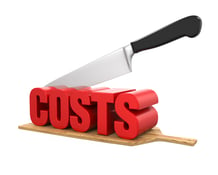While few restaurant operators miss the challenges of COVID-19 closures, many may be nostalgic for that era’s ultra-low egg prices. When restaurants were shuttered to dine-in patrons and egg demand was low, operators could purchase them for as little as $8 or $9 per case of 180. Those days are long gone.
Inflation and the Avian Flu: Ingredients for an Existential Crisis
For years now, inflation has wreaked havoc on both restaurant owners and their customers. Menu prices have risen alongside the cost of various groceries and wholesale ingredients. Egg prices in particular have seen budget-breaking spikes.
In January of 2023, the price of a dozen large, Grade A eggs reached its highest level in a decade. At that point, retail shoppers were shelling out more than $4.82 per carton. Though the overall price of food rose just 2.5% in 2024, the price of eggs is up 53% since last year.
We may, however, soon look back on early 2023 as the good old days of relatively manageable egg prices. Though inflation has gradually begun to subside on the whole, the US Department of Agriculture predicts a more than 20% increase in the cost of eggs throughout 2025. Compare that to the predicted 2.2% increase in overall food costs.
H5N1, an especially deadly strain of avian flu, is to blame. Sick chickens are the last thing beleaguered farmers, restaurant operators, and shoppers need in an era of inflation and supply chain uncertainty. Unfortunately, disease has spread amongst the nation’s poultry population for several years, infecting more than 145 million birds — 45 million (15% of the country’s egg-laying stock) in just the last four months.
Avian flu has infected and killed birds in all 50 states, with more than 600 counties hit. Wherever you call home, you and your customers have been affected and will continue to see the impact of avian flu.
Bakeries and breakfast spots are weathering the worst effects of the ongoing egg price crisis, but anyone who purchases eggs is likely to experience sticker shock. Though the average retail price of eggs has yet to surpass its record high, wholesale egg prices have never been higher.
Expana, an agricultural commodity price tracker, reports that eggs now cost $8 per dozen, over two dollars more than the previous record. They’re expensive by the case, too. Michael Saghian told Eater Houston that he’s now paying nearly $120 per case and losing $10,000 each month on eggs alone.
How are Restaurants Responding to the Price of Eggs?
Restaurateurs are taking various measures to manage rising costs and continue serving familiar dishes. Operators tend to fall into one of the following baskets.
Eating the Excess Costs . . . For Now
For now, many restaurants are still opting to wait and see. Saghian is keeping prices steady at his pair of New York Deli and Coffee Shop locations in hopes of continuing to meet customer expectations. “We try to keep our prices as low as possible,” he says, but he’s not delusional. He acknowledges that he can’t continue losing thousands of dollars on eggs indefinitely.
Other Houston operators interviewed by Eater said they’re staying the course as well. Ziggy Gruber, also a deli owner, says he spends around $18,000 on eggs each week and that his restaurant will continue to offer cakes, pies, matzoh ball soup, and other egg-based dishes at the prices customers expect.
Adding an Egg Surcharge or Raising Prices
While operators like Saghian are holding off on raising prices, others have made the difficult decision to pass egg costs onto the consumer. Liz Fleming and Paul Puma, owners of Philadelphia’s Ants Pants Cafe, are paying twice as much as usual for eggs. They raised menu prices six months ago and told the Philadelphia Inquirer that another increase could soon be on the way. “It’s scary,” Fleming remarks, “because how much are people going to pay for an omelet?”
Even large restaurant chains aren’t immune to factors like the rising price of eggs. Known for round-the-clock service and a broad menu of breakfast staples, Waffle House has recently made headlines for adding an egg surcharge to its menu. Cholesterol-conscious diners are used to forking over an additional fee for egg whites, but now everyone will pay an extra 50 cents per yolk at Waffle House restaurants.
Taking Eggs Off the Menu
Many eateries simply can’t afford to keep egg-based dishes on their menus without footing a too-hefty bill or asking their customers to do the same. Breadbelly in San Francisco is one such establishment. Diners will have to wait until prices go back down to drink Breadbelly’s egg coffee and owner James Wong says the restaurant’s popular egg salad bun could be the next menu item down.
Christine Ha, who operates a Houston drive-thru, has removed an egg salad sandwich from Stuffed Belly’s menu, though she says she hopes the change is temporary.
What’s Next for the Price of Eggs?
Will egg prices ever normalize? Back of House consultant and former restaurant operator Dan Durkin isn’t so sure. He warns restaurateurs that prices rarely go back down once customers have grown accustomed to paying more.
Take the mad cow scare of the early aughts, for example. When global buyers feared that American beef was tainted, they found a suitable substitute in Australian products. Durkin notes that the price of Australian beef rose to hit the average U.S. price and these costs have remained comparable in the years since.
One thing is certain, the price of eggs will remain volatile until affected farms manage to rebuild their flocks and stabilize the supply chain. Speaking to USA Today, Emily Metz, the American Egg Board’s CEO and president, said that mitigating the effects of bird flu is still a full-time job for egg farmers.
She concludes on a more hopeful reminder, though. Farmers, she suggests, have gained valuable experience over the last few years and are now capable of addressing risk factors and sick hens more efficiently.
Restaurant operators are learning valuable lessons too. Those who manage to thrive despite the rising price of eggs should have plenty of new insights to share with employees and creative solutions for combatting the future effects of inflation.
For restaurants specializing in breakfast, 2025 should offer plenty of additional challenges before it’s over. The USDA has warned that orange juice and coffee will cost more than they did last year. That’s not to mention all the changes in food and drink prices that tariffs against America’s top trade partners could produce.
Let’s Get Cracking
Whatever comes next, the experts at Back of House have the expertise and insights to help you find the right technology for managing costs, optimizing inventory levels, transforming workforce management, and more. Schedule a consultation today.





